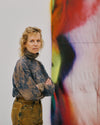
"A painting is simply a screen between the producer and the viewer, where both can observe the thought processes within it from different angles and moments in time. It allows me to look at the residue of my thinking."
— Katharina Grosse
In this edition of The Capsule, we want to highlight German visual artist Katharina Grosse (Freiburg, 1961), one of the most important figures in the contemporary art scene. She is known for her in situ paintings , in which she sprays paint directly onto spaces, creating an explosion of shapes and colors that transforms any space and expands the possibilities of painting beyond the traditional canvas.
Early in her career, during the 1990s, Grosse began painting, primarily interested in how colors and light effects translate into the shapes and compositions of canvases. In these early works, she continually repeated vertical forms with transparent brushstrokes to generate different lighting effects. From then on, the artist began experimenting off-canvas, making her first paintings on walls and staircases. Thus, she explored the expansive qualities of paint using a spray gun, a technique she has maintained throughout her career.
His first site-specific work using this technique was at the Kunsthalle Bern, Switzerland, in 1998, where he painted a corner of the gallery a deep green.
In the early 2000s, Grosse's distinctive style became more established, with "cloudy" effects in his paintings achieved through the use of a spray gun. In 2004, at the Contemporary Arts Museum in Houston, he sprayed the gallery interior, as well as clothing, papers, eggs, and coins scattered on the floor. In 2005, at the Palais de Tokyo in Paris, he hung two enormous canvases: one already painted and one blank. He painted the latter in situ , as well as the wall on which it hung. He then removed the painted canvas and leaned it on the floor against the wall, leaving a blank white rectangle.
In 2016, as part of a series of major public commissions in the United States, he created a work for MoMA PS1's Rockaway! series in Fort Tilden (Rockaways, New York), transforming an abandoned aquatic center with red, white, and magenta sprays.
Beginning in 2018, Katharina began incorporating large-format fabrics into her installations, combining the folds and shadows of the textiles with her signature spray paint. These include The Horse Trotted Another Couple of Metres, Then It Stopped (2018), created for Carriageworks in Sydney, which consisted of over 2,500 square meters of fabric suspended, draped, knotted, and folded across the building's 19th-century industrial architecture. In Wunderbild (2018), for the National Gallery in Prague, Grosse created an imposing series of paintings on loose fabrics, hung on either side of a room. All were painted on the floor of her studio in Berlin.
Her next major project will be an intervention at the Messeplatz at Art Basel 2025, curated by Natalia Grabowska, curator of architecture and site-specific interventions at London's Serpentine Galleries.
In short, Katharina Grosse has had a career marked by experimentation and the expansion of the boundaries of painting. The artist has managed to transform the way we perceive color, space, and matter. Her work continues to challenge the conventions of contemporary art, consolidating her as one of the most influential artists of her generation.

